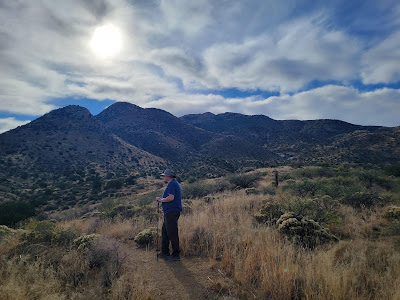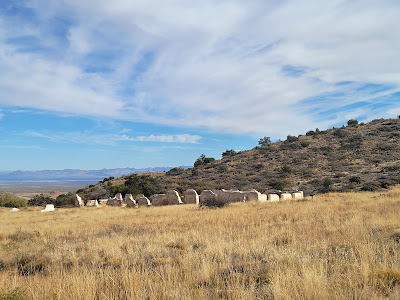Visited: Nov 2021
Nearby town: Willcox, AZ
"When I was young I walked all over this country, and saw no other people than the Apaches"
-Cochise
In the extreme southeastern corner of Arizona, you will find the ruins of the military outpost Fort Bowie.
This was a very neat place to visit. It's kind of an adventure to get out to. Exit the freeway (I-10) at the modern town of Bowie, head south on Apache Pass Road for about 20 miles (the road will eventually turn into a dirt road) to the trailhead. And then it's a 1.5-mile hike to the Visitor Center and the ruins of the fort. It was a beautiful hike through Apache Pass out to the site.
The Apache (a group of culturally-related Native American tribes) lived in this area for centuries. Apache Pass was the location of a natural springs that was the only water source for miles and miles. Thus, it was inevitable that other people (emigrants, missionaries, prospectors, pioneers, soldiers etc.) would cross through the area over the years. The Apache fought against the Spanish Empire and then the Mexicans for hundreds of years to combat encroaching settlements. The Apache gained a reputation for being fierce warriors and defenders of their homeland.
The United States acquired this territory from the Mexicans via the Treaty of Guadalupe Hidalgo at the conclusion of the Mexican War in 1848 and the Gadsden Purchase of 1853. As American settlers moved into the area, conflict with the Apache subsequently followed.
In 1861, a band of Pinal Apache raided the ranch of John Ward at Sonoita Creek, stole his livestock and kidnapped his 12-yr old son, Felix Ward. Witnessess saw the band escape towards the mountains of Apache Pass, and it was mistakenly assumed that the Chiricahua Apache, led by Cochise, had committed the crime because the Pass was the traditional homeland of Cochise. Ward appealed to the US Army to retrieve his son. Lt. George Bascom and a large group of infantry were ordered to find and return the young boy by any means necessary. Bascom met with Cochise and his family at Bascom's camp. Cochise denied responsibility and offered to help Bascom find the child. Cochise's offer fell on deaf ears, Bascom was convinced that Cochise was lying and was concealing the boy. Bascom attempted to arrest Cochise and his family, but Cochise himself managed to escape by using his knife to quickly slash a hole in the canvas on the side of Bascom's tent and fled. Cochise's band then surrounded Bascom's camp and demanded that Bascom free his family. Bascom refused. Cochise then took 3 American teamsters hostage, and attempted to exchange the prisoners for the release of his family. Bascom again refused. Cochise executed the three teamsters. In return, Bascom executed Cochise's brother and two nephews.
This incident, known as the "Bascom Affair" or "Bascom Massacre," led to open warfare between the Apache and the US Army that would last for decades.
Years later, the kidnapped boy was later found living among the Coyotero Apaches (who had raised him). The boy, now known as Mickey Free, eventually became an Apache Scout for the US Army and a bounty hunter. Mickey died in 1914, at the age of 65.
As you traverse the trail to the ruins of the Fort, you will pass through the valley where the "Basom Affair" occurred.
The Butterfield Overland Mail route came through Apache Pass. This was a stagecoach service that carried mail and passengers from St. Louis (or Memphis) to San Francisco.
It operated from 1858 to 1861.
Make sure to stop at the cemetery, a number of soldiers that were stationed at Fort Bowie are buried here. Others are also buried here, including one of Geronimo's sons, Little Robe.
Shortly after the Bascom Affair (Jan/Feb 1861), the Civil War broke out. In July 1862, a Union regiment, led by Brig. Gen. James Henry Carleton, left California and marched through Apache Pass on their way to confront Confederate troops in New Mexico Territory. As the soldiers entered the Pass, they were ambushed and attacked by 500 Apache troops, led by Cochise and Geronimo. The Union soldiers, with their superior weaponry, were able to hold off the attack, and the Apache retreated. The battle convinced the US Army to establish a fort in the pass to ward off Apache attacks and protect soldiers and other pioneers traveling through the area.
Construction quickly began. Fort Bowie, named after its first commander Col. George Washington Bowie, was completed in 1864.
As we continued along the trail, we passed the ruins of the Chiricahua Apache Indian Agency building and the Apache Spring itself.
a wickiup
Apache Spring - a very precious water source in this desert
Conflicts between the US Army and the Apache continued after the Civil War. In 1872, Cochise signed a peace treaty with the Army, in which he agreed that the tribe would live in a 3,000-sq. mile reservation that included, in part, some of their traditional homeland.
The peace was short-lived. Cochise died of natural causes in 1874. After his death, relations deteriorated yet again and US officials attempted to move the Apache to a different reservation, the San Carlos Reservation in the Gila River Valley, a few hundred miles to the north. Those who resisted, led by Geronimo, fled to Mexico and began to pester and terrorize the border region for several years. Geronimo finally surrendered in 1886, and he and his remaining followers were exiled to Florida. Geronimo died in 1909, at the age of 79, as a prisoner in Fort Sill, Oklahoma.
Geronimo's surrender marked the end of official hostilities between the US Army and the Apache. Fort Bowie was abandoned shortly afterwards, in 1894. The National Historic Site was established in 1972.
Once you reach the ruins proper, make sure to stop at the Visitor Center/Muesum to learn about the history of this area and the lives of the people who lived here. Then walk through the ruins to your heart's content.
Visitor Center/Museum
Relaxing at the Visitor Center. We pretty much had the park to ourselves.
many structures at the fort were made out of adobe
overlooking the Visitor Center and fort ruins
Walking back to our car, we soaked in the beautiful views of the Arizona landscape. We loved our visit at Fort Bowie. It was an adventure!
For more info: https://www.nps.gov/fobo/planyourvisit/index.htm






















































































No comments:
Post a Comment